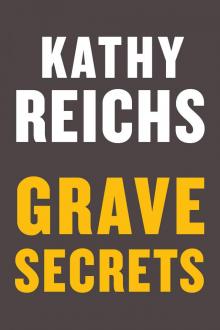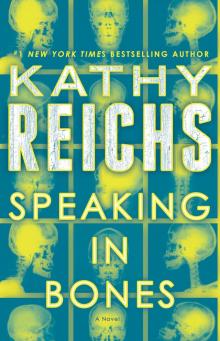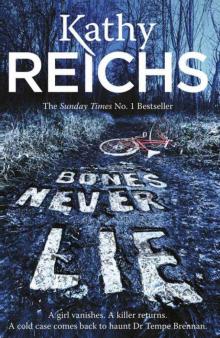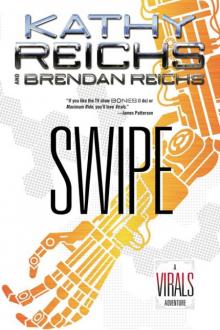- Home
- Kathy Reichs
Bones on Ice
Bones on Ice Read online
Bones on Ice is a work of fiction. Names, characters, places, and incidents are the products of the author’s imagination or are used fictitiously. Any resemblance to actual events, locales, or persons, living or dead, is entirely coincidental.
As of press time, the URLs displayed in this book link or refer to existing websites on the Internet. Penguin Random House is not responsible for, and should not be deemed to endorse or recommend, any website or content available on the Internet (including without limitation at any website, blog page, or information page) other than its own.
A Bantam Books eBook Original
Copyright © 2015 by Temperance Brennan, L.P.
Excerpt from Speaking in Bones by Kathy Reichs copyright © 2015 by Temperance Brennan, L.P.
All rights reserved.
Published in the United States by Bantam Books, an imprint of Random House, a division of Random House LLC, a Penguin Random House Company, New York.
BANTAM BOOKS and the HOUSE colophon are registered trademarks of Random House LLC.
This book contains an excerpt from the forthcoming book Speaking in Bones by Kathy Reichs. This excerpt has been set for this edition only and may not reflect the final content of the forthcoming edition.
eBook ISBN 9781101966822
Cover design: Carlos Beltrán
randomhousebooks.com
v4.1
a
Contents
Cover
Title Page
Copyright
Chapter 1
Chapter 2
Chapter 3
Chapter 4
Chapter 5
Chapter 6
Chapter 7
Chapter 8
Chapter 9
Chapter 10
Chapter 11
Chapter 12
Author’s Note
Dedication
Acknowledgments
Books by Kathy Reichs
About the Author
Excerpt from Speaking in Bones
Chapter 1
The transport van backed into the receiving bay, dark and silent. Standard. Morgue vehicles have no need of flashing lights or screaming sirens. There’s no urgency. Logos on the van’s windowless side panels proclaimed: INTERNATIONAL MORTUARY SHIPPING. My daughter, Katy, would’ve dubbed the thing a rolling kidnap trap.
The doors winged open and two uniformed techs hopped out and circled to the back. The taller of the pair had a shaved scalp marred by angry nicks. The shorter had buzz-cut hair and full-sleeve tattoos starting on his forearms and spiraling up toward rolled cuffs.
The men moved quickly and efficiently, opening the rear doors, hauling an oblong cardboard air tray from the van, and transferring it onto a gurney. It landed with a grating clunk.
Snapping on latex gloves, I stepped forward. The carton’s outer surface was stamped with three grisly words: HUMAN REMAINS. At one end, HEAD. The latter made me think of directions on a case of wine. THIS SIDE UP.
Shaved Scalp handed me a clipboard thick with paper. I skimmed a death certificate, a burial/transit permit, U.S. embassy international transport documentation, certification of noncontagious disease, an embalmment waiver.
Setting the paperwork to one side on the gurney, I used an X-Acto knife to slice the plastic binders, then eased off the carton’s cardboard cover. Inside was a zinc-coated metal container.
I flipped the butterfly hasps to unfasten the lid of the transport coffin. It opened with a hiss and a puff of icy vapor. I pulled back a large subzero gel pack covering the contents like a chill blanket and searched for the body bag’s ID data. The orange pouch was bunched, as if its occupant had been restless during the long journey home. After much rummaging, I found the tag, wiped frost from the plastic, and confirmed that the name and numbers matched those on the documentation.
“Will you wait for the container?” I directed my question to either tech.
Tattoo lifted a shoulder. “One use only.”
“Seems a waste.” Eyeballing the chilled metal box.
Another inky half shrug. “My granddad used one like it for storing fish that he caught.”
Shaved Scalp shot his partner a look of annoyance. To me, “If that’s all, ma’am?” Ready to go. Another corpse awaited. Another passenger who wouldn’t complain.
“That’s all. Thanks.”
While Shaved Scalp started the engine, Tattoo closed the van’s rear doors with a double thunk and climbed into the passenger side. Quick finger wave, and they were gone, leaving me alone with my frozen cargo.
Muscling the gurney through the bay doors, I was relieved to see Tim Larabee, my boss and Mecklenburg County’s chief medical examiner, loping toward me. He moved with the wiry grace of a longtime runner. Read: marathon junkie.
“Where do you want me today?” I asked.
“Take her into five.”
The new whiz-bang Mecklenburg County Medical Examiner facility, or MCME, completed in 2008 and LEED certified, boasts a shared refrigeration unit and four standard autopsy rooms. Two additional rooms are outfitted with special ventilation and disposal systems for postmortems involving decomps and corpses with potential for contamination. Number five was a “stinky” room and had its own cooler.
“Remind me why I won this lottery?” I wasn’t panting, but I was close. My load was heavy and the gurney had a bad wheel.
Larabee regarded me, puzzled but not breaking stride.
“Forensic anthropology? Bones? Mummies? Decomps?” I cocked my chin at the freight I was pushing. “Does this fall into one of those categories?”
“Not exactly.” Larabee did something with his lips meant to be a smile. “But, Tempe. You are the Queen of Ice and Snow.”
My eyes rolled at the tired old joke. At the label derived from my parallel position as forensic anthropologist for the Bureau du coroner in the Canadian province of Quebec. Yes, I split my time between Charlotte, North Carolina, and Montreal. Long story.
The split, I might add, is truly a wide one. A chasm. Different language, different city, different lab, different justice system. And the big gorilla: different climate. When temperatures move into the sixties, Charlotteans reach for jackets and gloves. Les Québécois break out their sandals and shorts.
North of the forty-eighth, death comes in ways rarely seen in Dixie. The hunter caught in the unexpected blizzard; the drunk staggering home from a bar; the underdressed driver leaving her broken-down car; the diaper-clad toddler wandering out into the night. Arctic winters mean hypothermia and bodies frozen solid.
Such cases usually don’t require my expertise. Cold kills, but it also preserves. I catch the long-gone dead. The family submerged in a frigid lake since the 1950s. The skier mummified for a decade then coughed up by an avalanche. The student fallen into a ventilator shaft and freeze-dried for five winters. Enter the Ice and Snow Queen of balmy North Carolina.
“You know the reward for winning the pie-eating contest, right?” I asked.
Again, the long Larabee stare.
“More pie.”
“They asked for you by name.”
“So you said.”
I pushed through the door into autopsy room five, bum first. As Larabee helped maneuver the gurney, I recalled our previous night’s conversation. He’d caught me at the Peculiar Rabbit with my best friend, Anne Turnip. Friday night. Trendy restaurant. Planning a trip to the Turks and Caicos. Not thinking about Ryan. Not thinking about The Proposal. Good times. Larabee’s call had not made my evening.
“We have an unusual case.” I knew from Larabee’s tone the news wouldn’t be good.
“Unusual?” Dunking a mussel in wine sauce, then popping it into my mouth.
“Frozen.”
I felt an urge to belt out a few lines o
f “Let It Go.” Anne and I were in that kind of mood. Instead I asked about a recent MP. The cops liked the husband for the lady’s disappearance, but so far no body. Perhaps wifey had turned up in hubby’s subzero.
“Melissa McLaughlin?”
“No. This case involves an accidental death on Mount Everest.”
I motioned to Anne that I needed to step away. The restaurant was packed and vibrating at runway decibel level. Obviously I’d misunderstood Larabee.
“Sorry, say that again?” Outside on the street.
“The victim is a Charlotte kid who died trying to summit Everest.”
Many questions jockeyed to be first in line. “Nepal is a bit out of our jurisdiction.” Or was it Tibet?
Larabee answered indirectly. “The family is…well connected. The mother, Blythe Hallis, is a friend of the mayor. And the police chief. And the governor. And…”
“I get it.” I did. A billion Charlotte landmarks bear the Hallis moniker. A boulevard. A park. A school. An endowed chair at the University of North Carolina at Charlotte. Big bucks. Big philanthropy. Big political influence.
“What’s the vic’s name?” I asked.
“Brighton Hallis.”
“How did she die?”
“It’s unclear. There were no witnesses, but the presumption has been a combination of high altitude, hypoxia, exhaustion, maybe disorientation…” Larabee let the grim thought hang.
Flashbulb image. Ice. Snow. Vacant-eyed Jack Nicholson from the end of The Shining. Despite the warm night, I shivered.
Point of information. The Queen of Ice and Snow detests cold weather. And is not wild about heights. I can’t imagine why anyone would want to climb any mountain. Ever.
“What’s the PMI?” I was asking about postmortem interval. Time since death.
“Three years.”
“Wasn’t the kid ID’d in Nepal?” Tibet?
“Yes.”
“So what’s the problem?”
“The mother’s concerned about chaos caused by the earthquake in Nepal. Thinks they’ll say anything to move another body along. Wants ID confirmed locally.”
“Shouldn’t they hire a private—”
“By us.”
A truck passed on the street, the driver grinding gears like a dirt biker gunning uphill.
“There’s no question of foul play?” Stalling. Larabee had already answered that.
“No. It’s a question of peace of mind. You wouldn’t believe what was required to bring this girl’s body back to Charlotte.” Larabee paused. A hitch in his breathing told me something was coming that I wouldn’t like. “Mrs. Hallis has requested, specifically and firmly, that you do the analysis.”
“What? Why?”
“Because you’re the best.”
“Spare me.”
“Should be a piece of cake.”
Behind me, a couple argued loudly. Something about beer and a guy named Weed. Or maybe a guy with beer and weed.
My contrary side wanted to be free to plan a summer vacation with Anne. To buy a new swimsuit, maybe some snorkeling fins. I also had to get to Montreal. I didn’t need extra work. Especially unofficial “do the mayor’s wealthy friend a favor” work.
A woman passed, leading what might have been a poodle. Behind me the squabble ratcheted up. The girl was definitely peeved at someone named Weed.
It shouldn’t be that difficult, my helpful side admonished. Dentals. Maybe prints. Match. Done.
Shit. I hated my helpful side.
“When does the body arrive?” Sighing with as much drama as the two at my back.
“Tomorrow, seven A.M.”
Seriously?
“Don’t worry.” At my nonresponse. “I’ll be up at dawn, too.”
And here we were. At eight-fifteen on a Saturday. In autopsy room five.
“Full-body scan?” Larabee asked.
“Eventually. Do we have antemortem facial shots?”
“Candids. And dentals.” Larabee handed me two envelopes I’d seen tucked into his breast pocket, one small and brown, one letter-size and white.
“I’m hoping for visual confirmation. If I can open the jaws, I’ll compare dental X-rays. If I can access the fingertips, I’ll take prints. Is she in the system?”
Larabee shrugged “who knows.”
“Hopefully that won’t be necessary for the prelim.” I was optimistic about an eyeball ID. Hypothermics are eerily preserved, if bluish, at the moment they slip away. “Once the body thaws, I’ll finish a complete analysis.”
“Is that necessary?”
“I do the exam right or I don’t do it at all.”
Larabee accepted this. All or nothing is how I roll. “So today some, Monday some?”
A frozen human isn’t like poultry you can zap and tease apart. If hurried, the body’s exterior warms faster than the gut, allowing the outside to decompose while the organs remain rock hard. Evidence can be lost. A corpse must thaw slowly, at a steady thirty-eight degrees. Depending on size and weight, the process can last three to seven days. Larabee knew that, too.
“Let’s hope she’s skinny” was all I said.
“Right. If you need more information, contact Blythe Hallis directly.”
“Will do.” Fervently hoping no call would be necessary.
“I’ll leave you to it.” Larabee headed off to have a proper Saturday morning. Maybe to run to Cleveland and back.
After snugging the gurney parallel to the autopsy table, I toed the brake, crossed to the counter, and scooped up the envelope holding Brighton Hallis’s dental X-rays. Sliding the contents onto a lightbox, I flipped the switch and arranged the small films by quadrants: upper, lower, front, back. The teeth appeared opaquely pale against the gray of the bone and the black of the background.
A crown on a first maxillary molar and fillings in two mandibular incisors glowed like dense white clouds in the surrounding enamel. I noted an odd curvature to the root of a second mandibular molar. A slight twist to one upper canine. No wisdom teeth.
Happy day. ID would be straightforward.
I crossed back to the metal transport container. Zinc. Good for temperature control, bad for X-rays. I used the wall phone to call for a tech.
While waiting, I masked and reopened the coffin. As before, chill damp air wafted out. Already it carried a hint of something familiar. Something sweet and fetid. Something inevitable. Oh so faint, but already sending out feelers.
On top of the orange body pouch lay a document noting gel pack replacement times throughout the long trip from Kathmandu, a protocol meant to ensure that a corpse remained frozen. International Mortuary Shipping was thorough.
I removed the paperwork and tugged free the gel packs, keeping one, chucking the others. When I’d finished, the body bag lay exposed. Lumps and sharp angles suggested the position of a hip, a knee, maybe a shoulder, a head. I gripped the zipper and tugged. It slid downward with a wet buzzing whrrrp.
Most victims of exposure die seated or lying down, perhaps having paused for a “quick rest.” That might account for the lumps. Or might not. Other than the gel packs, I had no idea how these remains had been handled in recovery and transport.
The body lay on its side, frozen, curved in on itself. It was fully clothed in serious mountaineering gear, feet encased in bright red gaitered boots. Long strands of hair emerged from a stiff North Face cap. Brassy now, the color was probably once blond.
The sight sent an unexpected wave of melancholy through me. The colorful puffy sport garments conjured images of bracing air, flushed cheeks, youth, adventure. Not sudden death. They did not belong here.
With almost no flesh exposed, I could determine zip about the body’s state of preservation. Impatient, I checked the time. Just after nine.
I assessed. The vic appeared to be tall but slender. There was little room in the container, but some manipulation was possible.
Hoping for a glance at the facial features, I grasped the downside shoulder and knee and
lifted. Nothing. I tightened my grip, pull-shoved, and the corpse rotated with a soft pop and a rustling sound.
Nose to nose with the grotesque face, my spirits plummeted.
Chapter 2
In her pre-ascent photo, Brighton Hallis stood smiling in front of a snowcapped peak. Blond and athletic, she could have stepped from an ad for a Ski Vail campaign. Tan, confident, pretty enough.
The face in front of me was shrunken and stained a deep mahogany brown, the shriveled lips drawn back in a rigor grin. The lidless eyeballs stared at me, disconcertingly lifelike, beseeching. How did this happen to me?
There would be no visual ID. Worse, not a tooth remained. In a face otherwise unnervingly intact, the dentition was shattered. Save for an outside chance on the odd root configuration, the antemortem dental records would be useless. Brighton Hallis’s charmingly crooked left canine remained as nothing but a jagged splinter.
The tech’s arrival interrupted my colorful expletive. He didn’t hear it. Or pretended not to. His name badge read J. Ortiz. I didn’t know him. I wasn’t that familiar with the weekend crew. Yay work-life balance.
After introductions and a brief strategy discussion, we got to work. Ortiz wasn’t a talker; I like that in a tech. Together we transferred the remains from the metal container to the autopsy table, then eased them free of the body bag. While Ortiz set up the camera, I penned info onto an ABFO ruler that would act as both scale and photo identifier. Then he snapped pictures as I jotted observations.
For several minutes the only sounds in the room were the squeak of Ortiz’s rubber soles and the click of the Nikon’s shutter release. Then, “No paradoxical undressing.”
At my raised eyebrows, Ortiz expanded. “I did some search and rescue in the Cascades, hikers and climbers lost during storms. Lot of them turned up with their clothes half-off.”
Severe hypothermia causes a nasty divorce between body and brain. One short-circuits the other. Disoriented, victims may begin taking off their clothes. The behavior is referred to as paradoxical undressing. Misinterpretations have led more than one investigation down the wrong path, untrained personnel suspecting a sexual assailant instead of Mother Nature.

 Two Nights
Two Nights The Bone Collection: Four Novellas
The Bone Collection: Four Novellas Fatal Voyage
Fatal Voyage 206 Bones
206 Bones Bones to Ashes
Bones to Ashes Terminal
Terminal Monday Mourning
Monday Mourning Flash and Bones
Flash and Bones Cross Bones
Cross Bones Devil Bones
Devil Bones Break No Bones
Break No Bones Swamp Bones
Swamp Bones Déjà Dead
Déjà Dead Shock
Shock Spider Bones
Spider Bones Death Du Jour
Death Du Jour Grave Secrets
Grave Secrets Trace Evidence: A Virals Short Story Collection
Trace Evidence: A Virals Short Story Collection Bones on Ice
Bones on Ice The Bone Code
The Bone Code Bones in Her Pocket
Bones in Her Pocket Seizure:
Seizure: Speaking in Bones
Speaking in Bones Deadly Decisions
Deadly Decisions Spike
Spike Bones Never Lie
Bones Never Lie Bones of the Lost
Bones of the Lost Virals 03.5 - Swipe
Virals 03.5 - Swipe Exposure
Exposure A Conspiracy of Bones
A Conspiracy of Bones Shift (tory brennan)
Shift (tory brennan) Bones of the Lost: A Temperance Brennan Novel tb-16
Bones of the Lost: A Temperance Brennan Novel tb-16 Virals tb-1
Virals tb-1 Bones Are Forever tb-15
Bones Are Forever tb-15 Code tb-3
Code tb-3 Seizure tb-2
Seizure tb-2 Deadly Descisions
Deadly Descisions Spider Bones: A Novel
Spider Bones: A Novel